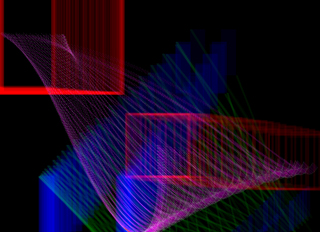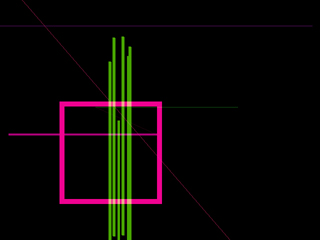Illumination Machine
Aleksandra Dulic: interactive animation, performance
Kenneth Newby: music composition, perfomance
Presented at:
New Forms Festival: Process Machines
Scratch video night at Sonar 2002
"After application of the pencil or any pointed tool, a (linear-active) line comes into being. The more freely it develops the, the clearer will be its mobility. But if I apply line, e.g. the edge of a block or colored crayon, the plane is produced.
If we had a medium that made it possible to move planes in a similar way, we should be able to inscribe an ideal three-dimensional piece of sculpture in space.
But I am afraid that it is utopian.”
— Paul Klee
The Illumination machine makes this possible.


Space carved from the history of the Bezier line movement
As an initial experiment in deep structure and formal heteroform across and among media elements we designed and built a simple generative art machine—The Illumination Machine— that combines real-time animation of basic visual and audible forms.
The core idea for the design of the illumination machine is the use of mathematical pattern as an underlying form—as a deep structure to articulate both aural and visual composition. We chose the mathematics of the Bezier curve as a deep structure from the desire to generate composition by curved lines and surfaces, which are more complex than rectangular forms and curves derived from arcs and circles. The mathematics of the Bezier4 curve provides a common deep structure for the rendering of both pictorial and aural form of the illumination machine.
The visual composition is comprised of spatial relationships among basic graphic elements and the variations on those basic forms. Two or more simultaneous renderings of surface elaborations and ornamentations based on a common synchronized deep structure provide the basis for the composition of the visual portion of the illumination performance machine.

The relationship between four control points and the Bezier curve
Given the five components of the deep structure, four control points and the curve itself at various degrees of resolution, different ways of mapping a visual representation on this deep structure were developed. An arbitrary shape or representation can be assigned to any of the control points and the curve itself. For our initial experiments we attached basic shapes such as circle, rectangle, line and dot to the control points and curve. Two approaches to rendering were found to be useful and resulted in quite different outcomes. The first was to clear the screen between renderings of updated control-point geometry along its Bezier or linear paths. This resulted in a familiar animation of the basic forms moving in space as independent objects (fig 1). The other approach was to not clear the screen between updates but let the drawing accumulate over time—retaining a history of the movement of the control points and curve in the virtual space and creating impossible curvature planes through a history of the Bezier path. This mode is specifically interesting because it draws a three-dimensional curved space.


The rendering of the underlying illumination machine form is achieved through the animation of control points defining a Bezier curve. Four control points are set in a three dimensional space and are animated along Bezier curve paths, which are generated by a random walk between target points the virtual space. The result is a dynamically evolving curve with a deep structure on which can be erected any number of visualizations or sonifications.
The sonification of the Bezier curve is achieved in an implementation of a justly-intoned pitch-space based on a two-dimensional array in the form of a Table of Pythagoras that creates a one-to-one mapping of the integers from 1-20.


This provides an rational ordering of musical intervals based on a harmonic and sub-harmonic series and its harmonic transpositions. The end-points of the Bezier curve are tied to the end-points of the diagonal elements of the array. The curve is used to define a path through the pitch-space. The number of points used to define the curve define the number of pitches being selected from the table. If the curve is straight the selected pitches will all be the same, i.e. 1:1, 2:2, 3:3, etc., which corresponds to the fundamental of the parent harmonic series of the table. The further from the diagonal path the curve traverses the table the further from this 1:1 fundamental the selected pitches will be. The resulting pitch sequences are mapped in time using a generative grammar to recursively divide up a temporal period corresponding to a musical bar .



Three Bezier paths through the pitch-space with interval ratios notated.
For the New Forms festival we used a two-screen display of the Bezier composition. This multi-screen display was a rhythmically synchronized display that shared a common geometry. Each Bezier space was equal and symmetrical at any given moment but had a different surface representation—Bezier points had varied shapes and colors that depicted the graphical outcome on each screen.
This animation of space provided a kind of choreography of form. The movement across the screens in space was the same, but the pictorial character within the displays was varying and complementary. These variations become a new kind of compositional or chorographical component. Two screens can share the time based rhythmic structure but have a contrast in pictorial rhythm of the screens. Different forms or constructions of complementary colors across the screens can be interactively modulated as a performative element of the screen’s space. As a result forms in light and color are dynamically transforming the visual space. One of the most exciting outcomes here is the ability to perform visual space with a balanced relationship of automatic and performative elements enabled by the illumination machine.
Isomorphic hetero-form is explored by synchronizing the underlying spatial geometry of the Bezier space. This is achieved by networking two computers that share the same Bezier geometry but vary the surface visualizations. The result is a generative and strongly correlated visual choreography among the visual elements of the composition.
The idea that with the manipulation of very few parameters it is possible to generate immense variety is related to some of the developments in computer music and audio synthesis. Several audio synthesis techniques based on non-linear distortion such as wave-shaping and frequency modulation can be controlled by just a few parameters to generate a great variety of sounds. The heteroform orientation that draws on Sumarsam’s idea of inner melody is achieved here—the deep structure of a Bezier curve equivalent here to an inner melody that all the surface formal elements are referring to. The multiple screen’s systems are synchronized with the same instantaneous geometry that is animated in the three dimensional space. They all share the same structure underneath the depicted surface and what we see is the variable yet deeply correlated surface. In mathematical terms the two displays are isomorphic with each other through the sharing of an equivalent underlying structure.